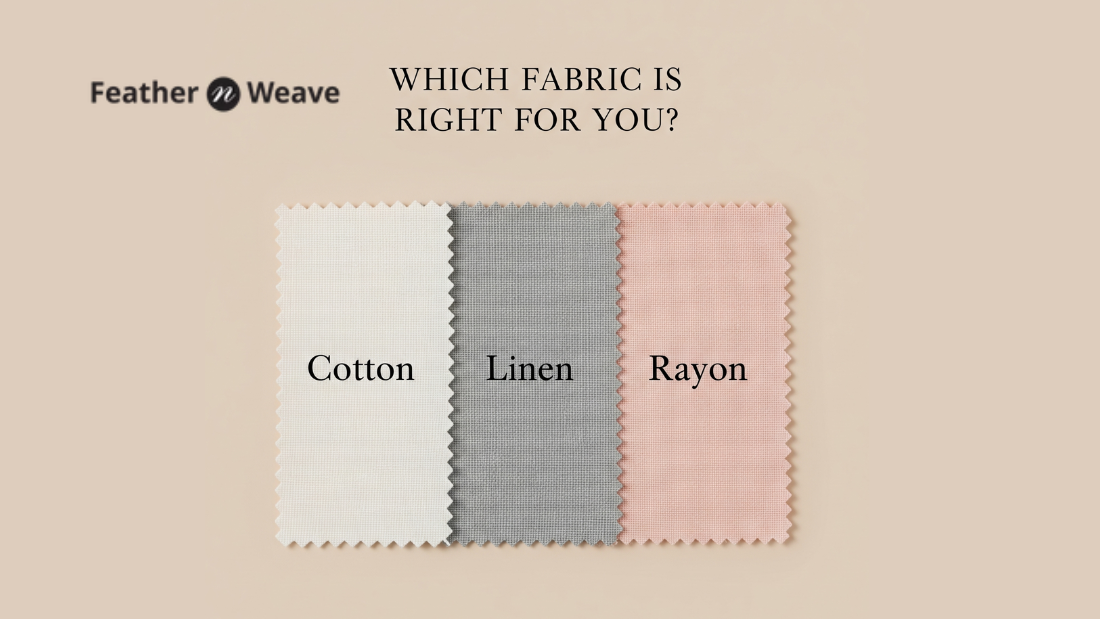
Cotton vs. Linen vs. Rayon: Which One’s Right for You?
Share
When it comes to choosing the perfect fabric for your wardrobe or home, it’s easy to get overwhelmed. Cotton, linen, and rayon are three of the most popular materials used in clothing and textiles but what sets them apart? Whether you’re shopping for something lightweight, eco-aware, or stylish, understanding these fabrics can help you make the best choice.
In this guide, we’ll break down the pros, cons, and ideal uses of cotton, linen, and rayon with a clear eye on sustainability, comfort, and long-term value.
Cotton: The All-Rounder (And Your Most Reliable Choice)
Origin: A natural fiber harvested from the fluffy seed hairs of the cotton plant — trusted globally for centuries.
Feel: Soft, smooth, and breathable. Cotton offers unmatched comfort against the skin, making it perfect for regular use.
Best for: Everyday wear, wraps, scarves, cushion covers, and more.
Pros:
-
Hypoallergenic and skin-friendly
100% pure cotton is naturally gentle — ideal for sensitive skin and those prone to irritation or allergies. -
Highly breathable & moisture-absorbent
Allows airflow and absorbs sweat — keeps you fresh in summer and layered in winter. -
Durable and long-lasting
Withstands frequent washing and heavy use while retaining shape and softness. -
Easy to care for
Machine washable; doesn’t need dry cleaning or special detergents. -
Timeless and versatile
From relaxed weekend styles to formalwear, cotton adapts to every trend and season.
Cons:
- Can shrink if not pre-shrunk or washed improperly
- Takes longer to dry compared to linen
- May wrinkle slightly over time (though many find this part of its natural appeal)
Sustainability Insight:
Pure cotton, when responsibly sourced, is natural, biodegradable, and recyclable. While cotton farming does use water, it’s a far safer and more eco-considerate option than synthetics or chemically-heavy fabrics like rayon.
Pro Tip:
If there’s one fabric you can trust for quality, comfort, and everyday practicality it’s pure cotton.
Linen: The Summer Favorite (But With Trade-offs)
Origin: Natural fiber derived from the flax plant.
Feel: Crisp, coarse, and loosely woven. Linen has a textured, earthy aesthetic.
Best for: Warm-weather styling, home decor, and occasional seasonal wear.
Pros:
Airy texture but not always comfortable
Linen lets some air through, but can feel drafty, stiff, and even scratchy in humid or mixed weather.
-
Strong but inflexible
While durable, linen's lack of flexibility results in a rigid drape and less softness than cotton. -
Softens over time after many washes
New linen can be coarse and rough; not ideal for those wanting instant comfort.
Cons:
-
Wrinkles easily
Requires regular ironing or steaming; can appear unkempt quickly. -
Feels rough initially
Not suitable for sensitive skin or prolonged wear without break-in. -
More expensive than cotton
Especially high-grade linen which doesn’t always justify the extra cost.
Pro Tip:
Linen may offer a cool, natural texture but be ready for stiffness, wrinkles, and higher upkeep. It’s best for occasional wear, not daily comfort.
Rayon: The Stylish Synthetic (But Not Without Consequences)
Origin: Semi-synthetic fiber made from chemically processed wood pulp.
Feel: Smooth, silky, and drapey often mimics luxury fabrics.
Best for: Trendy eveningwear and fashion pieces.
Pros:
- Feels soft like silk
- Drapes beautifully
- Absorbs dye well for vibrant prints
Cons:
-
Body Sensitivity:
Rayon traps heat and moisture, which may lead to rashes, irritation, or even fungal issues especially for sensitive skin. -
Environmental Concerns:
Made using harsh chemicals like carbon disulfide and sulfuric acid — which pollute water and harm workers in underregulated regions. -
Low durability:
Weak when wet, prone to shrinkage, wrinkles easily, and often needs dry cleaning.
Better Alternative:
If you’re looking for style and skin-safe comfort, pure cotton outperforms rayon on all practical fronts.
Avoid This:
We don’t use or recommend rayon. It’s chemically processed, low on comfort, and not skin-friendly. Choose safer, more natural fabrics like pure cotton.
So, Which Fabric Should You Choose?
Choose Pure Cotton The Gold Standard of Everyday Comfort
- Naturally breathable and soft
- Kind to sensitive skin
- Works across seasons and styles
- Easy to wash, wear, and maintain
Why it’s better:
Pure cotton is reliable, timeless, and completely natural no marketing fluff, just comfort you can feel.
Choose Linen For Occasional, Seasonal Style
- Good airflow in dry climates
- Rustic look that softens with age
- Not ideal for daily wear due to wrinkles and stiffness
For You If: You love texture and can handle upkeep.
Choose Rayon With Caution
- Stylish and soft-looking, but delicate and chemical-heavy
- Requires careful maintenance
- Avoid if sustainability or skin safety is a priority
Final Verdict: Go With Pure Cotton — It Just Works
For comfort, care, and long-term satisfaction, nothing beats 100% pure cotton. Whether it’s daily basics or timeless styles, cotton delivers on all fronts.
Fabric Caution: Avoid fabrics blended with polyester as:
- The production of polyester involves the use of petroleum and other resources, contributing to greenhouse gas emissions and other environmental impacts.
- Washing polyester garments releases microplastics into the water system, where they can harm marine life and potentially enter the human food chain.
- Polyester is a synthetic material that takes a long time to break down, contributing to landfills and environmental pollution.
Skip the hype. Stick to the real thing. Choose pure cotton.
Final Tip: Always check labels. Blends can compromise quality. Pure cotton brings peace of mind and consistent comfort.




